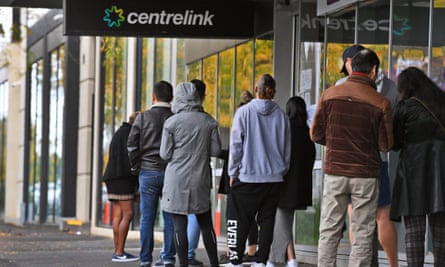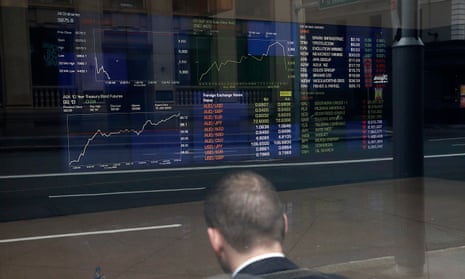You might remember the 2008 disaster movie, Market Meltdown, the one where hitherto mild-mannered suits become superheroes to save the global financial system from the brink of collapse. Now there’s a sequel, Market Meltdown II, in which a virus threatens to destroy the world economy before the suits return to slash interest rates and pump the system full of billions of dollars to save the world and send stock markets soaring back up.
To some, this redemptive plot line illustrates the resilience of the financial system. But a growing number of economists and investors believe that it shows only how broken the system has become, where the big end of town can profit so much while millions face an uncertain life on the dole.
Instead of sitting back and waiting for another post-financial crisis stock market and property bubble to be inflated again by the oceans of cheap money injected into the veins of the economy by central banks, including the Reserve Bank of Australia this time, critics say the situation provides a “once in a lifetime” opportunity to press the economic reset button.
First though, what has happened? Despite fears of a real market meltdown in March, stock markets have recovered almost to pre-crisis levels on the back of all that central bank and government intervention. Schemes like Australia’s jobkeeper to pay the wages of furloughed workers have also helped bolster confidence.
The Reserve Bank has already cut interest rates to 0.25% and with a program of quantitative easing, or money printing, the prospect of negative rates is no longer just the stuff of economic theory. One leading economist, Bill Evans at Westpac, thinks that is where the RBA should be headed.
This policy approach flows from the powerful US Federal Reserve and its ultra-loose monetary policy, which has seen it pump $1.5tn into the financial system since March, and is here to stay, as chairman Jerome Powell made quite clear this week.
The good news for Australia this week was that the country’s economy, although already in recession, according to the treasurer, Josh Frydenberg, could emerge from the coronavirus carnage stronger than most, with gross domestic product shrinking by a mere 5%. In contrast, the UK’s GDP fell more than 20% in April and could contract by a whopping 11.5% over the whole of 2020.
The bad news hidden by this relatively benign forecast is that Australia’s response risks entrenching growing inequality and job insecurity, which were already beginning to drag on growth before the pandemic hit.
Eleanor Creagh, of Saxo Capital Markets in Sydney, says it had not been the intention of the central banks to inflate a bubble in assets but “we have reached a point where the side-effects are producing a risk asset bubble that is decoupled from the economy”.
Greg McKenna, chief executive of Police Bank and a former market strategist, says the response to every crisis in the markets has been the same for the last 30 years, leading to lower and lower interest rates. But he says a point has been reached where the policy is no longer doing what it says on the tin because people cannot borrow any more and are using any spare cash to pay back debt.
“If they’re not interested in borrowing at these ultra-low rates, then another two-fifths of nothing won’t make any difference. In an uncertain world where savings are low, the policy of negative rates means that people are paying down debt and consuming less – the exact opposite of the paradigm the central banks want to achieve.”
Central banks have to turn round to governments and shout “no more”, McKenna says, putting into blunt terms what RBA governor Philip Lowe has been trying to say to the government since his tenure began. It no longer matters whether the government can keep its surplus or the country’s AAA credit rating.

“Who cares about the AAA rating?” McKenna says. “We just care about getting as many Australians in work as possible. Firstly for the societal good and secondly for the economic good.
“We need a more diversified economy, one not just about real estate, banking and minerals. It’s a once in a lifetime opportunity and we should take it. We need to invest more in communities and people.”
The Coalition in power in Canberra would say they have done just that and – although they will never admit it – will be keen to be compared favourably to the response of the Rudd government in 2008. While much of the bubble-inducing stimulus in Australian markets was the result of the US Fed a decade ago, the direct handouts to households are credited with helping Australia become the only advanced western economy to avoid recession back then.
But the Morrison government is keen to phase out the jobkeeper scheme as soon as possible and get back to its agenda of cutting taxes and delivering a surplus, although the latter seems a long way off now given the billions spent keeping the economy afloat.
For Prof Bill Mitchell, the University of Newcastle economist who developed the radical idea of modern monetary theory, we are living with the consequences of reforms introduced decades ago.
“This is the end point of a long series of legislative and regulatory decisions that have allowed a disproportionate amount of freedom to financial markets,” he says, highlighting the deregulation of banks that have turned once sober lenders into “casinos” and the introduction of negative gearing, which created speculation around real estate.
“We need to revisit these components of neoliberalism in Australia that have enriched a small proportion of the population, just about preserved the middle class, but eaten away at the bottom 40%.”
Politicians may bridle at the idea of sweeping new regulations but there are calls for change. Greens leader, Adam Bandt, says there is “a real risk” that the massive government coronavirus subsidies would just be used for “speculation”, prolonging existing problems and doing nothing to reduce inequality.
“We can’t afford to let this happen,” he says. “The government should spend big on the infrastructure and services we need to address the jobs crisis, the economic crisis and the climate crisis. We need government-led investment in renewable energy, manufacturing, public housing and public transport, as well as expanding the education and training system needed to skill up the workforce.”
Jim Chalmers, the shadow treasurer, says the government’s “inaction and incompetence” in the lead-up to the crisis left the Reserve Bank to do all the heavy lifting.
“While the Reserve Bank is doing its bit to support the economy, the Morrison government is putting jobs at risk through their bungling of key programs like jobkeeper and having no plan for a stronger, inclusive and sustainable recovery,” he says.
However, there is a wider political difficulty to consider in the wake of the street protests that have erupted in the United States over race and which have spread around the world, including to Australia. They show urban populations in the mood to revolt, so governments face a new challenge: any reform taken now could make economic damage worse in the short-term.
Eleanor Creagh points out that the current system is so skewed by years of cheap money that markets are not functioning properly because capital is not being allocated to productive areas.
But the alternative of reshaping the economy would involve a lot of pain, she says, such as allowing weaker businesses to go bust – the so-called zombie companies that cannot refinance their debts and many of which are surviving the crisis only through government support.
“The alternative might be where you would allow a reset, you allow zombie companies to fail,” she says. “But I don’t think that would be palatable for governments, central banks and other participants.
“There is already a lot of discontent, as the street protests have shown. We expect to see more unrest and more expressions of discontent as underlying problems are exacerbated by economic issues.”
So as another bubble takes shape and the world lurches back to the status quo, stand by for the third part of the Market Meltdown franchise – perhaps it might be called Zombie Company Apocalypse.

Comments (…)
Sign in or create your Guardian account to join the discussion